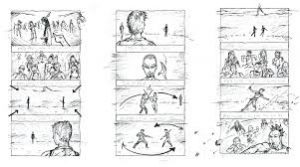
Creating a Storyboard
Part 1: Story boarding
This week, you will start work on a detailed course project, and you will be adding to the project as you progress with the course each week.
This week, you will begin by creating a storyboard for an application.
Using any graphic resources, such as scanning hand-sketched paper drawings or using Microsoft Paint or Adobe Photoshop, create a simple storyboard to examine a possible project and unify a team around a design.
To do so, complete the following tasks:
In a 2- to 3-page Microsoft Word document, propose an application, that is, small software which performs a service on a mobile device or on a smart phone or tablet.
Make the purpose small and achievable. For example, imagine an application that constantly keeps you updated on what is happening in the class, with classmates posting and commenting on your work and assignments. Be sure to explain the purpose of your proposed application.
Create at least six screens representing various states of the interface depending on what the user does or selects. Using images, demonstrate how an application like this might work: Open and close screen options and simple branching.
Note: Do not use any video in this application. Just develop a storyboard, which can be created on paper and then scanned or use Drawing or Diagramming in Google Drive.
Part 2: Capturing Design Requirements
Continuing with the assignment you started in Week 1, in this assignment, you will study how the design requirements for an application are captured. In Week 1, you created a storyboard. This week, you will analyze the design requirements and create a wire-frame for your application.
Using the South University Online Library or the Internet, research how the design requirements for a project may be specified.
Click here to view a video that will introduce you to Google Sites. You need to create something along the lines of rapid prototyping with Google Sites and Drives.
Based on your research and readings and viewings in the week, add a minimum of three pages to the Microsoft Word document from W1 Assignment 3 to include the answers to the following questions:
Are decision trees, navigation maps, and storyboards enough for your design to represent the hierarchy of information or do you require an additional tool for the same? Give reasons in support of your answer.
Is it important to map the physical interaction of users with the design requirements of the intended interface? Why can’t we perform both of these activities in isolation? Give reasons for your answer.
Additionally, continuing with the assignment you started in Week 1 Assignment 3, complete the following tasks:
For the proposed application in Week 1 Assignment 3, develop a wireframe of your design. This can be developed in any tool you are comfortable with or with Google Drive Drawing, but the emphasis of evaluation will be on the quality and depth of the design decisions you make. Identify your users and imagine how they might work. The wireframe must be submitted to the W2 Assignment 2 Dropbox.
Part 3: Defining User Goals
This week, you will continue with the detailed assignment you started in Week 1.
In Week 1, you created a storyboard for your application, and in Week 2, you created a wireframe for the application. This week, you need to document user goals.
In the Microsoft Word document you created in W2 Assignment 2, add 2–3 pages to complete the following tasks:
Perform a task analysis, and write the steps needed to complete the task. You can divide a task into subtasks. Use appropriate task scenarios.
In your design, also consider the futuristic Google Glass or Microsoft Surface project and imagine how technology such as this could change your existing design.
As you work on the design, you can refer to the Futuristic Technology category in the Webliography to know more about these technologies.
Part 4: The Design Document
Continuing with the detailed project from W3 Assignment 2, where you documented user goals, this week, you will develop a paper prototype for the design of your proposed application, which can be tested. The prototype should demonstrate the following:
An understanding of user needs
A data analysis of user needs
The task analysis and decision tree
The prototype should be on paper or use index cards to represent starts and screens.
Click here to view a video sample.
Conduct testing on the paper prototype through appropriate task scenarios and storyboards.
Document the results of your testing.
Additionally, begin assembling your professional design document. Create a Microsoft Word document that will include:
An introduction
Your target audience
The storyboard
The results of your testing the prototype
Plan for evaluation
Approach the project as a portfolio project suitable for submission for a professional position as a mobile designer. There is no page or word limit, but the assignment will be evaluated based on the quality of work and thought.
Course Project—Part 5: Analysis of Design
Using the skills you have studied and developed in the course, complete the following tasks:
• Work with a classmate and provide a detailed critical analysis of the design document presented by the classmate. You could use Google Docs to share your design documents with each other and your instructor. Click here to go to Google Drive, where you may create and share your documents.
• Present a completely commented analysis of the design document.
• At the bottom of the design document, include “future directions” for your classmate’s design.
• Include the link to a Google Drive presentation to illustrate what your Microsoft Word document states.
We can write this or a similar paper for you! Simply fill the order form!
